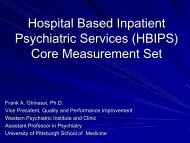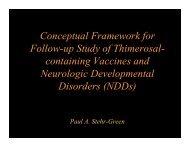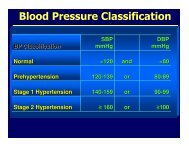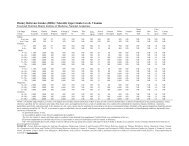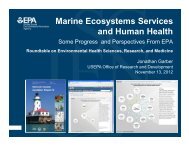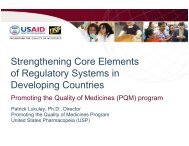Diekema.ppt [Compatibility Mode] - Institute of Medicine
Diekema.ppt [Compatibility Mode] - Institute of Medicine
Diekema.ppt [Compatibility Mode] - Institute of Medicine
Create successful ePaper yourself
Turn your PDF publications into a flip-book with our unique Google optimized e-Paper software.
Febrile Seizures Associated with Trivalent<br />
Influenza Vaccine and 13-Valent<br />
Pneumococcal Vaccine 2010-2011 Season<br />
Decision Making by the ACIP General<br />
Recommendations Working Group<br />
Subgroup on Febrile Seizures<br />
Jeff Duchin MD<br />
Chief, Communicable Disease & Immunization Section<br />
Public Health – Seattle & King County<br />
Pr<strong>of</strong>essor in <strong>Medicine</strong>, University <strong>of</strong> Washington
Febrile Seizure Signal Detection<br />
• April 2010, Australia: Increase in febrile seizures 0-1<br />
days after vaccination <strong>of</strong> children
Febrile Seizure Signal Detection<br />
Enhanced monitoring in US<br />
• November, 2011: VAERS enhanced surveillance<br />
detects increase in febrile seizure reports after trivalent<br />
influenza vaccine (TIV) administration; most in children<br />
6-23 months<br />
• In US, Fluzone ® only TIV product administered to<br />
children 6-23 months during the 2010-2011 season<br />
• Vaccine Safety Datalink (VSD) revises risk interval to 0-<br />
1 days after vaccination for surveillance for seizures<br />
•Signal for seizures detected in November, 2011 in 6-<br />
59 month old children<br />
•Subsequent evaluations to evaluate whether signal<br />
represented true increase in risk<br />
•Febrile seizures appeared associated with receipt <strong>of</strong><br />
TIV and pneumococcal conjugate vaccine (PCV13)
Febrile Seizure Signal Detection<br />
Enhanced monitoring in US<br />
• FDA and CDC Announcements on Fluzone ®<br />
and febrile seizures<br />
•Update on Fluzone ® Influenza Vaccine and VAERS<br />
Reports <strong>of</strong> Febrile Seizures in Children (January 20,<br />
2011)<br />
• Update: Vaccine Adverse Events reporting System<br />
(VAERS) Data on Febrile Seizures after Vaccination<br />
with Fluzone ® , a 2010-2011 Trivalent Inactivated<br />
Vaccine, in Children (January 21, 2011)<br />
http://www.fda.gov/BiologicsBloodVaccines/SafetyAvailability/VaccineSafety/ucm240037.htm<br />
http://vaers.hhs.gov/resources/VAERSupdate_FebrileSeizures_Children.pdf<br />
DeStefano, ACIP FEB 2011
ACIP General Recommendations Working Group<br />
Febrile Seizure Subgroup<br />
• Charge (March 2011):<br />
–Review data on the risk for febrile seizures after<br />
seasonal trivalent inactivated influenza vaccine (TIV)<br />
and pneumococcal conjugate vaccine (PCV) in<br />
children<br />
– Present options to ACIP for any action(s) related to<br />
the use <strong>of</strong> these vaccines for the 2011-12 influenza<br />
season<br />
–Provide a framework for determining when vaccineassociated<br />
febrile seizures should lead to a change in<br />
recommendations for administration <strong>of</strong> one or more<br />
vaccines
General Recommendations Working Group<br />
Subgroup on Febrile Seizures<br />
Chair Jeffrey Duchin<br />
CDC<br />
Andrew Kroger<br />
William Atkinson<br />
Elizabeth Briere<br />
Karen Broder<br />
Jonathan Duffy<br />
Lisa Grohskopf<br />
Nancy Levine<br />
Elaine Miller<br />
Matt Moore<br />
Gina Mootrey<br />
Glen Nowak<br />
Larry Pickering<br />
Tom Shimabukuro<br />
Jean Smith<br />
Greg Wallace<br />
ACIP<br />
Mike Marcy<br />
Mark Sawyer<br />
Jon Temte<br />
Wendy Keitel<br />
Consultants<br />
Doug Campos-Outcalt<br />
Ge<strong>of</strong>frey Evans<br />
Stanley Grogg<br />
Neal Halsey<br />
Sandra Jo Hammer<br />
Stephan Foster<br />
Andrea James<br />
Harry Keyserling<br />
David Menschik<br />
Walter Orenstein<br />
Lorry Rubin<br />
Janice Sullivan
Febrile Seizures<br />
Background<br />
• Seizures that occur in febrile children that do not<br />
have intracranial infection, metabolic disturbance<br />
or history <strong>of</strong> afebrile seizures<br />
• Typically occurs at 6-60 months; peak: 14-18 months<br />
• Affects 2-5% <strong>of</strong> children in the US<br />
• Generally excellent prognosis, few sequelae<br />
• 1/3 with first febrile seizure will have recurrence<br />
• Fever reducing medications have not been<br />
shown to prevent febrile seizures
Febrile Seizures and Vaccines<br />
Background<br />
• Fever following vaccination can potentially increase risk<br />
for febrile seizures in children<br />
• Known associations with febrile seizures and whole cell<br />
pertussis vaccine and measles-containing vaccines<br />
• Attributable risk<br />
• DTwP: 6-9/100,000 doses1,2 • DTwP: 6-9/100,000 doses1,2 •MMR: 24-156/100,000 doses 1,2,3<br />
•MMR-V: 38-43/100,000 doses 4,5<br />
• DTaP NOT associated with increased risk for febrile<br />
seizures 6<br />
1 Farrington. Lancet, 1995; 2 Barlow. NEJM, 2001; 3 Vestergaard. JAMA,<br />
2004; 4 Jacobsen. Vaccine, 2009; 5 Klein. Pediatrics, 2010; 6 Huang. 2010,<br />
Pediatircs.<br />
DeStefano, ACIP FEB 2011
ACIP Recommendations for Influenza<br />
Vaccination for Children Aged ≥6 Months<br />
• Annual vaccination recommended for all persons ≥6<br />
months<br />
–For some children 6 mo. through 8 yrs receiving seasonal<br />
influenza vaccine for the first time, two doses are<br />
required to ensure adequate immune response<br />
– Doses must be administered a minimum <strong>of</strong> 4 weeks apart<br />
• Schedule determined to some extent by time <strong>of</strong><br />
year (vaccine becomes available approximately in<br />
September)<br />
–Optimal protection afforded by administration <strong>of</strong> both<br />
doses early in season<br />
MMWR 2010;59:1-62
ACIP Recommendations for Pneumococcal<br />
Conjugate Vaccine (PCV13)<br />
• For routine immunization <strong>of</strong> infants, PCV13 is<br />
recommended as a 4-dose series at ages 2, 4,<br />
6, and 12--15 months<br />
•2010 recommendation for PCV13 superseded 2000<br />
ACIP recommendation for PCV7<br />
•2010-11 first season with PCV13 in widespread<br />
use<br />
MMWR. December 10, 2010 / 59(RR11);1-18
Febrile Seizures Signal in the Vaccine Safety Datalink<br />
(VSD) Harvard Pilgrim Health Care <strong>Institute</strong>, Southern<br />
California Kaiser Permanente, Centers for Disease<br />
Control and Prevention<br />
• Presented preliminary findings at February and<br />
June 2011 ACIP meetings<br />
• Methods and results published in February,<br />
2012<br />
•Tse et al. Vaccine 2012; 30:2024-2031<br />
11
VSD monitoring for febrile seizures after 2010-11<br />
trivalent inactivated influenza vaccine (TIV)<br />
• VSD monitored 9 outcomes after TIV, including seizures<br />
– ICD9 code for convulsion (780.3)<br />
– Inpatient and emergency department setting (High positive<br />
predictive value)<br />
• Detected possible increased risk <strong>of</strong> febrile seizures on<br />
days 0-1 post-vaccination among 6-59 mo who received<br />
1st 1 dose <strong>of</strong> TIV (signal)<br />
st dose <strong>of</strong> TIV (signal)<br />
– Chart review verified most seizures were febrile<br />
– Risk appeared higher in 6-23 month old children<br />
– Most had received other vaccines, most commonly 13-valent<br />
pneumococcal conjugate vaccine (PCV13) and DTaP<br />
– Re-evaluation <strong>of</strong> data from past seasons using 0-1 day interval<br />
did not show similar elevation in risk for seizures<br />
– No increase in risk <strong>of</strong> seizures following monovalent H1N1<br />
vaccine in 2009-2010 season<br />
Lee, Tokars, ACIP February, June 2011
Lee, ACIP June 2011
Lee, ACIP FEB 2011
Lee, ACIP FEB 2011<br />
16
Lee, ACIP FEB 2011
Lee, ACIP FEB 2011<br />
18
Lee, ACIP FEB 2011<br />
19
Joint Signal Evaluation for TIV and PCV-13<br />
•Harvard Pilgrim Healthcare <strong>Institute</strong>,<br />
Southern California Kaiser, CDC<br />
•Evaluate<br />
– Influenza (+/- other vaccines)<br />
–Influenza +/- PCV-13 (+/- other vaccines)<br />
–PCV-13 (+/- other vaccines)<br />
Lee, ACIP FEB 2011
Lee, ACIP FEB 2011<br />
21
Lee, ACIP FEB 2011<br />
22
(~1 excess febrile seizure in 1640 vaccinees)<br />
Lee, ACIP FEB 2011 23
Lee, ACIP FEB 2011<br />
24
Attributable risk (per 100,000 doses)<br />
Updated Attributable Risk <strong>of</strong> Febrile Seizures by<br />
Age Group and Concomitant PCV13<br />
100<br />
80<br />
60<br />
40<br />
20<br />
0<br />
-20<br />
23.2<br />
0.0<br />
6.02<br />
42.1<br />
9.7<br />
5.04<br />
9.4<br />
▲ TIV + PCV13**<br />
u TIV**<br />
n PCV13 **<br />
0.5 -1.0<br />
6-11 months 12-23 months 24-59 months<br />
Cases Risk* 6 0 5 9 5 6 2 3 0<br />
Cases Control* 4 0 6 5 3 8 1 9 3<br />
Vaccinees 20,917 19,458 42,088 17,999 42,67856,747 18,28186,841 65,503<br />
* Duration 2 days for risk interval vs. 7 days for control interval<br />
**+/- other vaccines Tokars. ACIP June 2011
Updated VSD Analysis, August, 2011<br />
• New method for estimating attributable risk<br />
• Uses information on baseline risk for seizures by<br />
age in months from the entire VSD population<br />
(provides more stable estimates), rather than<br />
estimating baseline risk from the control period<br />
for broad age intervals (where there are fewer<br />
cases and more uncertainty about baseline risk<br />
estimates despite the broad age interval).<br />
• Highlights substantial variation in AR by age in<br />
months, which is due to the variability in baseline<br />
risk by age in months.
Risk difference per 100,000 doses<br />
Attributable Risk (AR) estimates for febrile seizures<br />
following 1 st dose TIV, 2010-11 ^ (Updated AUG 2011)<br />
60<br />
50<br />
40<br />
30<br />
20<br />
10<br />
0<br />
6 78910<br />
TIV without concomitant PCV13* PCV13 without concomitant TIV*<br />
Concomitant TIV + PCV13*<br />
45/100,000 (~1 excess febrile seizure in 2222 vaccinees)<br />
16<br />
17<br />
18<br />
19<br />
20<br />
21<br />
22<br />
23<br />
24<br />
25<br />
26<br />
27<br />
28<br />
29<br />
30<br />
31<br />
32<br />
33<br />
34<br />
35<br />
36<br />
37<br />
38<br />
39<br />
40<br />
41<br />
42<br />
43<br />
44<br />
45<br />
46<br />
47<br />
48<br />
49<br />
50<br />
51<br />
52<br />
53<br />
54<br />
55<br />
56<br />
57<br />
58<br />
59<br />
11<br />
12<br />
13<br />
14<br />
15<br />
Age in months<br />
^Tse A and Lee G for the VSD<br />
*Vaccines may have been received concomitantly with non-TIV, non-PCV13 vaccines
VSD Analysis - Comments<br />
• Compares risk <strong>of</strong> febrile seizure for TIV +<br />
PCV13 administered simultaneously to no<br />
vaccination, not to TIV and PCV13 given<br />
separately<br />
• Point estimates have wide confidence intervals<br />
(small numbers <strong>of</strong> cases)
Burden <strong>of</strong> Influenza Among Children in the US<br />
• Complications:<br />
–Respiratory (pneumonia, sinusitis, otitis media<br />
–viral and secondary bacterial)<br />
–Musculoskeletal (myositis, rhabdomyelitis)<br />
– Cardiac (myo/pericarditis)<br />
–Neurologic (seizures, encephalopathy,<br />
encephalitis)<br />
–Exacerbations <strong>of</strong> chronic conditions (asthma,<br />
cardiac)
Burden <strong>of</strong> Influenza Among Children in the US<br />
• Hospitalization and mortality rates vary by<br />
season, age group. Hospitalization estimates<br />
from 2003/4 - 2007/8:<br />
–
Benefit <strong>of</strong> Influenza Vaccination<br />
• Number needed to vaccinate to prevent one<br />
hospitalization from influenza: 1031 – 3050 (at<br />
50% vaccine efficacy in children 6-23 months <strong>of</strong><br />
age)<br />
– Lewis EN, Griffen MR, Szilagyi PG, et. Al. Pediatrics, 2007.
Febrile Seizures After Influenza Infection<br />
• Influenza A associated with 17.6% <strong>of</strong> 923 hospitalized febrile<br />
seizures over 5 years (Chung et al)<br />
• In 1997 and 1998, influenza A accounted for 10.8% and 21.7%<br />
<strong>of</strong> febrile seizure admissions, respectively (35% and 44%<br />
during periods <strong>of</strong> peak flu activity) (Chiu et al)<br />
• 19.5% <strong>of</strong> children admitted with influenza A developed febrile<br />
seizures (Kwong et al)<br />
• Positive seasonal correlation noted between peak influenza<br />
activity and febrile seizures (Van Zeijl et al)<br />
• Of 435 children 6 months -4 years <strong>of</strong> age hospitalized with<br />
lab-confirmed influenza during 4 seasons (2000-2004), 27<br />
(6.2%) had febrile seizure (Newland et al)<br />
• Of 74 children hospitalized with influenza A H1N1, 14 (19%)<br />
had neurological complications and 6 (8%) had febrile<br />
seizures<br />
Chiu SS et al. Pediatrics 2001;108:1-7.; Kwong KL et al. Pediatr Neurol 2006;35:395-399. Chung B et al.<br />
Arch Dis Child 2007;92:589-593. Van Zeijl et al. J Pediatr 2004;145:800-805; Newland J et al. J Pediatr<br />
2007;150(3):306-310; Landau Pediatr Neurol 2011
U.S. Burden <strong>of</strong> Pneumococcal Disease Among<br />
Children
13-valent Pneumococcal Conjugate Vaccine<br />
(PCV13)<br />
• Introduced into routine schedule in March 2010<br />
• Replaced PCV7, which was associated with<br />
prevention <strong>of</strong> 211,000 cases <strong>of</strong> IPD during 2000-<br />
2007 (Pilishvili JID 2010)<br />
• Recommended for all children at 2, 4, 6, and 12-15<br />
months<br />
• Relevance <strong>of</strong> booster dose in 2 nd year <strong>of</strong> life:<br />
•Additional individual protection over primary series<br />
•Likely important for mucosal immunity (pneumonia, otitis)<br />
•Considered important for reducing transmission to other<br />
age groups
Seasonality <strong>of</strong> Invasive Pneumococcal Disease<br />
-Children 12-23 months, 1998-2008<br />
60% <strong>of</strong> annual IPD cases occur<br />
during October-March<br />
CDC, Active Bacterial Core surveillance, unpublished
October 2011 ACIP Meeting<br />
General Recommendations Working Group<br />
Febrile Seizures Subgroup - Assessment<br />
• Significant morbidity <strong>of</strong> influenza and<br />
pneumococcal disease among children<br />
• Timely vaccination important in preventing seasonal<br />
morbidity and mortality for influenza and<br />
pneumococcal infections requires<br />
• Likely benefit <strong>of</strong> vaccination in preventing febrile<br />
seizures due to influenza and pneumococcal<br />
infections<br />
• Potential for missed opportunities if schedule modified<br />
• Although distressing, febrile seizures largely<br />
benign<br />
37
October 2011 ACIP Meeting<br />
General Recommendations Working Group<br />
Febrile Seizures Subgroup - Assessment<br />
• Unclear if risk after simultaneous administration <strong>of</strong> TIV<br />
and PCV13 is greater than with separate administration<br />
• Unclear if association between influenza vaccine and<br />
febrile seizures is unique to 2010-2011 vaccine strains<br />
• Cases with concurrent infection not excluded from<br />
analysis<br />
• Relatively small numbers <strong>of</strong> cases<br />
• Further investigation is underway to determine if other<br />
vaccines besides TIV and PCV13 may be contributing to<br />
the febrile seizures<br />
• Evaluation <strong>of</strong> confounding or effect modification by concomitant<br />
administration <strong>of</strong> DTaP with PCV13 or TIV<br />
38
October 2011 ACIP Meeting<br />
General Recommendations Working Group<br />
Febrile Seizures Subgroup - Conclusions<br />
• Benefits <strong>of</strong> TIV and PCV13 vaccination >> risk<br />
• Education <strong>of</strong> healthcare providers and parents<br />
on the increased risk <strong>of</strong> febrile seizures and<br />
benefits <strong>of</strong> TIV and PCV13<br />
• No change in recommendation for simultaneous<br />
administration
www.cdc.gov/vaccinesafety/Concerns/FebrileSeizures.html
www.cdc.gov/vaccines/pubs/vis/
www.cdc.gov/vaccines/pubs/vis/
Proposed Framework for Determining When<br />
Vaccine-Associated Febrile Seizures Should Lead<br />
to a Change in ACIP Recommendations<br />
• Confirmation <strong>of</strong> febrile seizures through review <strong>of</strong> clinical<br />
data and standardized classification<br />
• Level <strong>of</strong> certainty vaccine is causing observed increase<br />
in seizures<br />
– Timing <strong>of</strong> seizures related to vaccine administration<br />
– Association with administration <strong>of</strong> a single vaccine, multiple<br />
vaccines, or specific vaccine doses in a series<br />
– Additional factors that might influence or confound the<br />
association (E.g., increased circulation <strong>of</strong> naturally-occurring<br />
infection; medications; underlying conditions)<br />
• Age stratified rate and relative risk <strong>of</strong> vaccine-associated<br />
febrile seizures and excess cases expected in the<br />
population<br />
• Evidence for potential explanations (I.e., new product,<br />
new vaccine ingredient or manufacturing process,<br />
adulterant, etc.)
Proposed Framework for Determining When<br />
Vaccine-Associated Febrile Seizures Should Lead<br />
to a Change in ACIP Recommendations<br />
• Benefits <strong>of</strong> vaccine(s) associated with seizures by age<br />
group (key outcomes prevented)<br />
• Effect <strong>of</strong> vaccine(s) on preventing febrile seizures<br />
• Association expected to be temporary or ongoing?<br />
• Potential for change in recommendations to result in<br />
missed opportunities to vaccinate or unintended<br />
decreased vaccine uptake with resulting increase in<br />
naturally-occurring infections<br />
• Acceptability to healthcare providers and the public <strong>of</strong><br />
potential options under consideration for change in<br />
recommendations<br />
• Programmatic implications and feasibility <strong>of</strong> making<br />
changes in recommendations


![Diekema.ppt [Compatibility Mode] - Institute of Medicine](https://img.yumpu.com/5085552/1/500x640/diekemappt-compatibility-mode-institute-of-medicine.jpg)
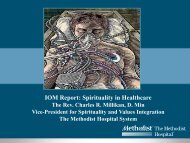
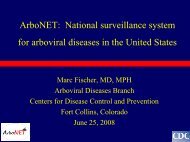

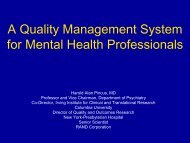
![Barry Davis Presentation.ppt [Read-Only] - Institute of Medicine](https://img.yumpu.com/31160415/1/190x146/barry-davis-presentationppt-read-only-institute-of-medicine.jpg?quality=85)
